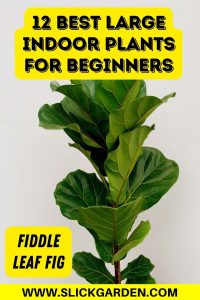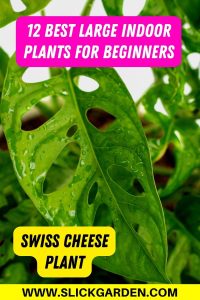Most people don’t have outdoor space for growing plants but they are interested in gardening. They should not lose their heart as they can grow many plants inside their home.
Houseplants bring you close to nature, there are many benefits of growing plants indoors. Plants make your mood fresh and purify the air around you. You can also show your creativity and aesthetic sense by adding colorful plants.

Some people like to grow large plants, for those people this article is going to be very interesting. As we are going to give you a list of large plants that you can easily grow indoors.
1- RUBBER PLANT

Rubber plant has large, oval-shaped, and glossy green leaves that look fabulous. It is the best large indoor plant. When you grow a rubber plant in a pot then it can grow up to 6 to 10 feet.
This is a low-maintenance plant and you can propagate it easily. It can tolerate low light conditions as you know when you grow plants indoors it is not possible.
If you are a beginner you should choose this plant for your living room or drawing-room. This plant needs an infrequent watering cycle and slightly moist soil. If you are growing rubber plants in potting soil then no need of adding fertilizers for a long time.
Rubber plants remove pollutants from the air. This plant can reduce formaldehyde, carbon monoxide, and carbon dioxide from the surrounding air.
2- FIDDLE LEAF FIG

The size of the fiddle leaf fig plant can easily be controlled, that’s why you can grow it as a houseplant. This plant has large, leathery, glossy, and dark green with yellow veins leaves.
You can easily propagate it from the cuttings or you can buy potted plants from a local nursery or gardening store. This plant-like grows in bright and filtered light so you should rotate the pot every month so the light reaches each part of the plant.
You should use well-drained and rich soil for growing fiddle leaf figs. The suitable temperature for this plant is 65 to 80 degrees Fahrenheit or 15 to 26 degrees centigrade.
The warm climate is perfect for the growth of this plant. Fertilize your plant every month but avoid it in winter. When you see damaged or overgrown leaves then remove them from the plant.
If you see white diffuse patches on the leaves of the plant it means that your plant is affected by common pests such as spider mites or scales.
3- FISHTAIL PALM

This plant has fishtail-like leaves that’s why it’s called fishtail palm. This plant likes to grow in indirect bright light so you should place the pot near the window where your plant gets sufficient light.
Make sure you are using well-drained soil for growing fishtail palm. This plant likes to grow in a warm and humid environment. A humidifier is the best way to provide the best surroundings to your plant.
4- ANTHURIUM

There are 1000 species of anthurium in the world. This is the best plant as a large indoor plant. This plant can easily survive in low light conditions. This is a low-maintenance plant and doesn’t need water regularly.
Overwatering can become a reason for destroying your beautiful anthurium plant. Overwatering results in root rot that can kill your plant. Apply a fertilizer that contains phosphorus because after adding it you will see beautiful flowers on your anthurium plant.
5- CORN TREE

It is an ideal houseplant as it naturally purifies the air of your surroundings. This plant can remove the toxins such as ammonia, formaldehyde, and xylene from the air.
This plant can survive in any condition but you should avoid overwatering and over-fertilizing. If you see the yellow leaves then it means your plant is getting too much water.
The container which you use for growing plants should have drainage holes at the bottom. This will help to drain the excess water from the container. If your corn plant grows very tall then you can prune it to give its suitable size according to your desire.
This plant can propagate easily with the help of cuttings. This plant grows slowly and can reach a height of 6 feet in a container.
6- DESERT TREE

The beautiful red flowers and green leaves make this plant stunning. The height of this ranges between 2 to 5 feet. The addition of this plant will enhance the beauty of your living drawing-room.
When you are growing it as a houseplant then terracotta pots are the best choice for this purpose. The suitable temperature for growing a desert tree is 72 to 100 degrees Fahrenheit or 21 to 38 degrees Centigrade.
Cactus potting mix is best for growing plants. When the soil dries then water the plant. You can use your finger to check the soil if it feels moist then you should not water the plant.
7- UMBRELLA PLANT

The Umbrella plant requires little maintenance and has glossy foliage. Choose a bright spot for growing umbrella plants. This plant has elongated deep, that’s why it resembles the umbrella.
This is an air purifier plant that can remove toxins from the air. The height of this plant can reach up to 5 to 6 feet if you grow it in a pot. Make sure the pot you are using for growing the umbrella plant should have drainage holes at the bottom.
The suitable temperature for growing this plant is about 57 to 90 degrees Fahrenheit or 14 to 30 degrees centigrade. Temperature fluctuation is not suitable for this plant.
Well-drained and loamy soil is perfect for growing umbrella plants. When you see the surface of the soil is dry then water your plant and avoid overwatering because it can cause root rot. You can apply 20-20-20 liquid fertilizer for the healthy growth of your plant.
8- PHILODENDRON

This plant has attractive, shiny, and dark green leaves. You can easily grow a philodendron without facing any difficulty. This is a decorative plant and has many varieties.
A humid environment and indirect light are best for growing philodendron plants. You should use rich, loamy, and moist soil. You can add coconut fiber or coco peat to the soil to make it rich in organic matter.
You should place your pot near a window or door where your plant gets indirect light. If you see the leaves are turning yellow it means that your plant is getting too much light.
Whenever you see the dry surface of the soil then water authority your plant but avoid overwatering because voice soil can cause root rot. The best temperature for growing philodendron is above 55 degrees Fahrenheit or 12 degrees Centigrade.
9- SWISS CHEESE PLANT

This plant has large and heart-shaped leaves. Bright and indirect light is needed for the thriving of this large tree. If you expose the container or pot of this plant to direct sunlight then the leaves of the plant can burn easily.
You are using a peat-based potting mix that will help to retain the moisture. The pH of the soil should be between 5.5 to 7. You can use your finger to check the soil of the container before watering.
If the soil is dry then you should water the plant. The suitable temperature for growing this plant is above 40 degrees Fahrenheit; the ideal humidity level is above 50%. To maintain the humidity you can use a humidifier for this purpose.
10- DRAGON PLANT

Dragon plant is a very attractive houseplant with sword-like leaves. This is a slow-growing plant that produces tiny white flowers in the spring. If you grow a dragon plant in a container then it can reach a height of 6 feet.
This is a toxic plant so you should keep it away from pets. Indirect bright light is required for the development of your dragon tree. Indirect light the foliage of the tree can burn.
You should use a well-drained and loose potting mix in the container. You should use a large container so the roots of the plant get ample space. The suitable temperature of growing dragon trees is about between 70 to 80 degrees Fahrenheit.
Pruning keeps the shape of the plant according to your desire. You can easily propagate dragon trees with the help of stem cuttings or you can also buy a small plant from any local nursery or gardening store.
As your plant grows you should shift it into a larger container so the roots of the plant get the room for further development.
11- BIRD OF PARADISE

This plant looks great when you place it in your living room or drawing-room. The part of your container that you are using for growing smaller bird-of-paradise plants should be at least 12 inches wide and deep.
In case you have a large plant then you should arrange a 34 inches deep and white container. Fill the container with two parts of potting mix and one part of the perlite; this will help to improve the drainage quality of the growing medium of the container.
Overwatering can damage your plants so you should avoid it. Bird of Paradise is a heavy feeder so you should fertilize more frequently than other plants. You should apply fertilizer every two weeks in the spring and once a week in summer.
In winter this plant doesn’t need fertilizer because the growth is very slow. The suitable temperature for growing this plant is 70 degrees Fahrenheit.
12- CROTONS

This plant is found in red-green Ivory, copper, orange, pink and brown colors. There are more than a hundred varieties found in the world. When you grow Croton plants in your home then they will bring liveliness to your place where they are kept.
The beautiful color and unique pattern of glossy leaves of this plant enhance the beauty of your living room. This plant is a fast grower and can be reached up to the height of 10 feet.
You can also buy a dwarf variety that can grow up to 3 feet. Mostly the length of the leaves is about 4 to 6 inches and the width is about 2 to 4 inches.
4 to 5 hours of bright sunlight is very important for the growth of a Croton plant. Make sure the container or pot should be kept at that place where it gets maximum sunlight.
If you place your container or pot in the partial shade then the leaves of the plant will become dull. The suitable temperature for the growth of this plant is about 60 to 75 degrees Fahrenheit or 15 to 24 degrees Centigrade.
